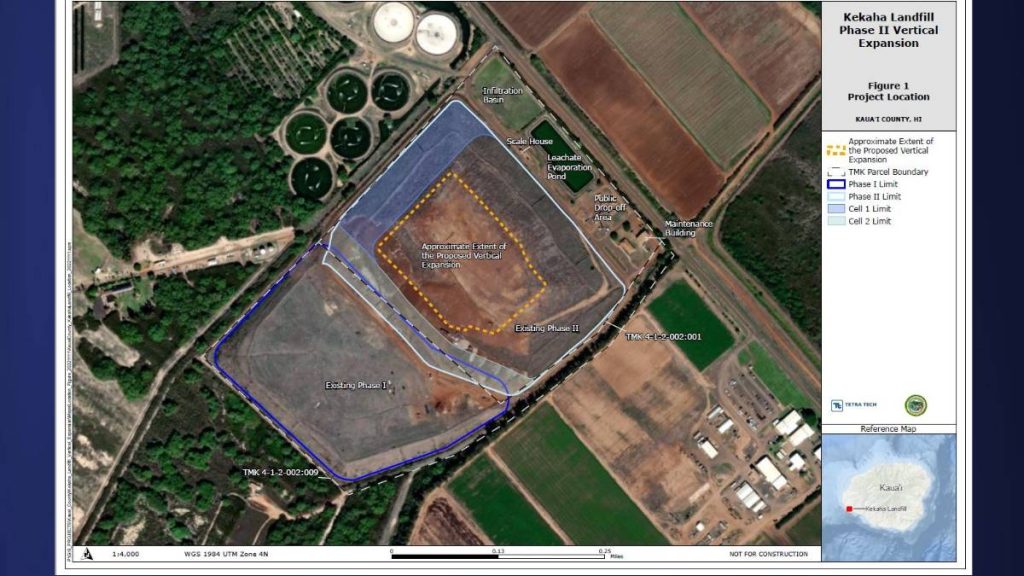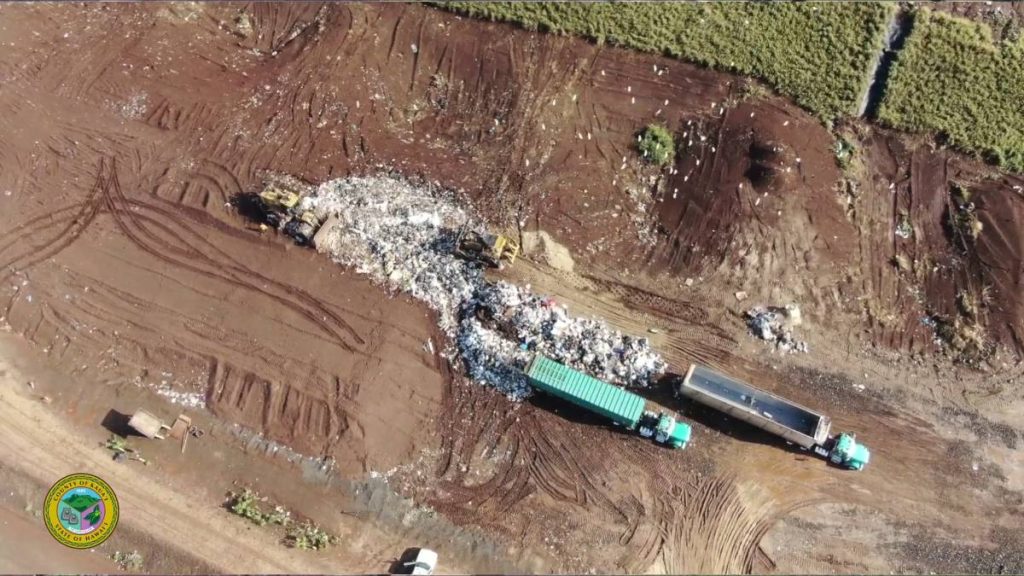Discussion continues for long-term solution on near-capacity Kaua‘i landfill
The Kaua’i County Council held a briefing on plans for the near-capacity Kekaha Landfill earlier this week, revealing that a long-term solution for managing the island’s trash has not been found.
“We know we have limited capacity. We feel the pressure, obviously,” said Allison Fraley, an environmental services manager with the county, during the Aug. 8 council meeting.
“We do need capacity. And so we’re working with concurrent solutions … to make sure we have capacity both in the long term and in the short term,” she said.
Fraley and Troy Tanigawa, a county engineer who also works for the Department of Public Works Solid Waste Division, had been requested to provide an update on the landfill issue by County Council Chair Mel Rapozo.
The progress they reported at this meeting was similar to the information they shared at a state Board of Land and Natural Resources meeting over seven months ago, in December 2023.
Fraley shared that the current landfill, known as Phase 2, is expected to reach maximum capacity in June 2027, at a height of 120 feet above sea level. As a temporary solution, the county is currently working on the Kekaha Landfill Expansion Project to vertically expand the landfill’s capacity by 50 feet, up to 170 feet.
At the island’s current disposal rate of 60 tons of trash per day, or 90,000 tons of trash per year, the expansion would extend the life of the landfill through 2030, providing an additional three years of space.
Fraley said an environmental assessment, published in February 2024, found the expansion would have no significant impact on residents or the environment.
“We have an application into the state Department of Health, which is going to be approved by the department, and then we’ll be able to expand upward in 2027,” she said.
The other part of the Kekaha Landfill, which is currently not in operation, consists of a 39-acre area where facilities closed in October 1993. Fraley discussed plans to build a new fill area over the closed landfill cell’s waste, allowing for an additional 85 feet of capacity. The construction of that site would require reconsolidating existing waste, grading slope for drainage, and an overliner.
The plan requires an Environmental Impact Assessment, land use permits, and Department of Health approval, which Fraley said will take an estimated four years to implement.
Fraley did not provide information on how long the 85-foot expansion would be able to accept trash. In December 2023, she had said the cell’s capacity would depend on its design.
The other option discussed was a new landfill.
During the meeting, Fraley said that a site has been identified six miles west of the Kekaha landfill. With the nearest resident living 9 miles away, Fraley noted that it complies with Hawaii’s Act 73, which requires landfills to be at least half a mile from residential areas.
That site has not been confirmed, and there have been issues with locating sites due to residential concerns and environmental laws. Fraley said if the proposed site is approved, it will take an additional year for conceptual design drawings, engineering analysis, and to go through the permitting process.
Other long-term solutions have also been discussed.
For the last several months, the Public Works Department has also been working on issuing a Request for Proposals (RFP) for potential alternative technologies for long-term solid waste management on the island.
In December 2023, Fraley said in an email response that the RFP would likely be advertised in early 2024.
However, during the Aug. 8 meeting, Fraley told council members the RFP was finished but has not yet been released. She stated Public Works is currently working with the County Attorney’s Office to make sure the solicitation will not result in a protest or be canceled because of conflicting terms and conditions.
“We have to make sure that we take our time … to avoid problems in the future,” Fraley said.
Rapozo and other council members questioned the seeming lack of progress with the RFP process.
“That’s been the response for quite a while,” he said in response to Fraley. “We’ve been doing this for quite a while. So I think when can we expect that (RFP) to go out.”
Fraley, Tanigawa and council members also discussed alternative technologies being considered including using incineration to burn trash.
However, Rapozo raised concerns about the high cost of waste-to-energy technologies.
“We learned the painful reality of the cost on an incineration-type facility,” Rapozo said, noting that an operator had provided a ballpark estimate of $1.2 billion for installation.
Other alternatives or solutions to slow the accumulation of waste in the landfill include increasing the county’s focus on composting and recycling.
“I fully feel that sense of urgency because we need to stay the Garden Island and not become the Garbage Island,” said Councilwoman Felicia Cowden.
In closing comments, council members emphasized the importance of composting, recycling, and an urgent need to finally find a solution to the issue that began over 20 years ago.
“I’m usually an optimistic person, but I am very concerned,” Rapozo said. He was also concerned about Fraley’s proposed new site for a landfill having not yet been approved by the DLNR, saying that its approval is not guaranteed. “If we don’t get the land, then everything else is no good. We gotta redo it all,” he said.
“I’m scared. Cost-wise, We’re talking about waste to energy and landfills that cost hundreds and hundreds of millions of dollars to construct. Where do we get that from?”
Earlier in the meeting, Rapozo had said money in the county budget would need to be prioritized to go toward the landfill.
“Some of the amenities that we want, that we had asked for [need] to be put on hold,” he said.
“I’m at that point because I’m scared.”
Corrections:
- An earlier version of this story incorrectly stated that Councilwoman Felicia Cowden said three-quarters of the waste in the landfill was compostable. In fact, it was a public testifier who made the claim. The incorrect information has been removed from the article.













